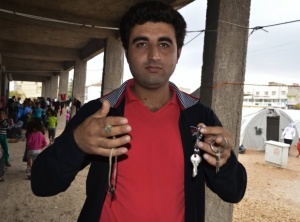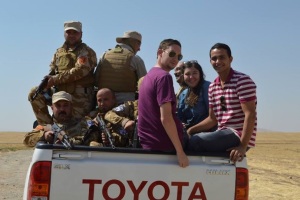By Abed al-Qaisi (Palestinian territory), Matthew Vickery (Scotland) & Sheren Khalel (Palestinian territory/USA)
“What do people take with them when they onlyhave a matter of seconds or minutes to escape? What stories, histories, emotions and thoughts does that item bring, and how does it now bring comfort?” That’s the questions  Palestinian photo- and videographer Abed al Quaisi, Scottish researcher Matthew Vickery and Palestinian-American journalist Sheren Khalel raised in their multimedia-piece about refugees at the Turkish-Syrian border. Their aim was to show the individuality of each person, rather than seeing them purely as a number published by refugee organisations or NGOs.
Palestinian photo- and videographer Abed al Quaisi, Scottish researcher Matthew Vickery and Palestinian-American journalist Sheren Khalel raised in their multimedia-piece about refugees at the Turkish-Syrian border. Their aim was to show the individuality of each person, rather than seeing them purely as a number published by refugee organisations or NGOs.
The project:
„The problem often with reporting in conflict zones is the potential for refugees to be dehumanised.With the sheer numbers of people who flee, individuals and families become subsumed into numbers, figures to be digested in news reports – their individuality lost.
In “Fleeing Kobane: Only the things they could carry,” we looked to bring that human edge back, our aim was to show the individuality of the person, rather than seeing them purely as a number published by refugee organisations or NGOs. To do this, we went basic. What do people take with them when they only have a matter of seconds or minutes to escape?
By doing this, we looked into the regular lives of refugees, who clutch family photos, heirlooms, keys, tattered religious volumes. The things that, while running for their lives, were still precious enough to turn back for. In the narrative that we spun – and the video report and photos we produced – we helped to put across the importance, for example, that an engagement ring hurriedly grabbed can mean to a young women when everything else is lost, the hope that a tattered archaic Quran can bring to an elderly man who has never seen such turmoil in his life before.
People’s lives matter, and in “Fleeing Kobane”, we attempted to tell the stories of refugees from Kobane, not just through their own words, but though items of emotional value that show just how alike we all really are, and how behind the numbers are real, relatable people“
The collaboration: 
Matthew Vickery: „All of us firmly believe in the benefits of working together as a team, particularly in conflict areas. Working together on this project allowed the three of us to focus on our individual strengths, putting them together to produce a solid package. In particular, as Abed is a refugee himself, he was able to relate to the people we spoke and interviewed in a way that many foreign journalists couldn’t hope to – allowing greater insight and access to the refugees we spoke to, who admitted to being more willing to put their emotions and thoughts ‘out there’ with someone who they saw similarities with.
The aspect of safety in numbers is also very influential in our decision to tackle projects together in and around conflict zones. While covering “Fleeing Kobane” we worked in Suruc, a Turkish border town beside Kobane, where fighting rages on only a few kilometres away, and the threat of Islamic State kidnappings are high, particularly for foreign journalists. By working as a team and a tight unit that trusts each other, we were able to go through every potential decision – where we will travel, who will take us there – with three minds vetting every process.“
Published at Middle East Eye, (16 October 2014) http://www.middleeasteye.net/in-depth/features/fleeing-kobane-things-they-carried-1981346566
